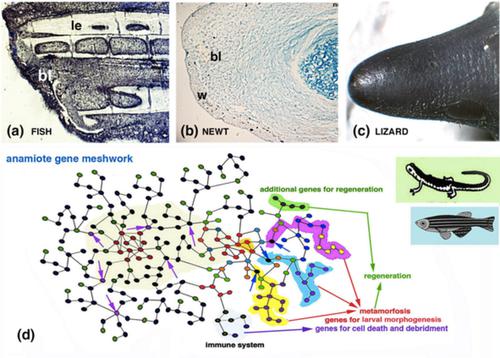当前位置:
X-MOL 学术
›
J. Morphol.
›
论文详情
Our official English website, www.x-mol.net, welcomes your
feedback! (Note: you will need to create a separate account there.)
Appendage regeneration in anamniotes utilizes genes active during larval‐metamorphic stages that have been lost or altered in amniotes: The case for studying lizard tail regeneration
Journal of Morphology ( IF 1.5 ) Pub Date : 2020-08-31 , DOI: 10.1002/jmor.21251 Lorenzo Alibardi 1
Journal of Morphology ( IF 1.5 ) Pub Date : 2020-08-31 , DOI: 10.1002/jmor.21251 Lorenzo Alibardi 1
Affiliation

|
This review elaborates the idea that organ regeneration derives from specific evolutionary histories of vertebrates. Regenerative ability depends on genomic regulation of genes specific to the life‐cycles that have differentially evolved in anamniotes and amniotes. In aquatic environments, where fish and amphibians live, one or multiple metamorphic transitions occur before the adult stage is reached. Each transition involves the destruction and remodeling of larval organs that are replaced with adult organs. After organ injury or loss in adult anamniotes, regeneration uses similar genes and developmental process than those operating during larval growth and metamorphosis. Therefore, the broad presence of regenerative capability across anamniotes is possible because generating new organs is included in their life history at metamorphic stages. Soft hyaluronate‐rich regenerative blastemas grow in submersed or in hydrated environments, that is, essential conditions for regeneration, like during development. In adult anamniotes, the ability to regenerate different organs decreases in comparison to larval stages and becomes limited during aging. Comparisons of genes activated during metamorphosis and regeneration in anamniotes identify key genes unique to these processes, and include thyroid, wnt and non‐coding RNAs developmental pathways. In the terrestrial environment, some genes or developmental pathways for metamorphic transitions were lost during amniote evolution, determining loss of regeneration. Among amniotes, the formation of soft and hydrated blastemas only occurs in lizards, a morphogenetic process that evolved favoring their survival through tail autotomy, leading to a massive although imperfect regeneration of the tail. Deciphering genes activity during lizard tail regeneration would address future attempts to recreate in other amniotes regenerative blastemas that grow into variably completed organs.
中文翻译:

羊膜动物的附肢再生利用在羊膜动物中丢失或改变的幼虫变态阶段活跃的基因:研究蜥蜴尾巴再生的案例
这篇综述阐述了器官再生源于脊椎动物特定进化历史的观点。再生能力取决于特定于生命周期的基因的基因组调控,这些基因在羊膜动物和羊膜动物中进化不同。在鱼类和两栖动物生活的水生环境中,在达到成虫阶段之前会发生一次或多次变质转变。每个转变都涉及被成体器官取代的幼虫器官的破坏和重塑。在成虫的器官损伤或丢失后,再生使用与幼虫生长和变态过程中运行的基因和发育过程相似的基因和发育过程。因此,羊膜动物的再生能力的广泛存在是可能的,因为在变质阶段的生活史中包括产生新器官。富含透明质酸的软质再生胚泡在水下或水合环境中生长,即再生的必要条件,如发育过程中。在成年羊膜动物中,与幼虫阶段相比,再生不同器官的能力下降,并在衰老过程中变得有限。比较羊膜动物变态和再生过程中激活的基因,确定了这些过程特有的关键基因,包括甲状腺、wnt 和非编码 RNA 的发育途径。在陆地环境中,在羊膜进化过程中,一些基因或变质转变的发育途径丢失,决定了再生的丧失。在羊膜动物中,柔软和水合胚泡的形成只发生在蜥蜴身上,这是一种形态发生过程,进化有利于它们通过尾部自切术生存,导致尾巴大量但不完美的再生。在蜥蜴尾巴再生过程中破译基因活动将解决未来在其他羊膜动物再生胚泡中再生的尝试,这些胚泡长成可变完整的器官。
更新日期:2020-08-31
中文翻译:

羊膜动物的附肢再生利用在羊膜动物中丢失或改变的幼虫变态阶段活跃的基因:研究蜥蜴尾巴再生的案例
这篇综述阐述了器官再生源于脊椎动物特定进化历史的观点。再生能力取决于特定于生命周期的基因的基因组调控,这些基因在羊膜动物和羊膜动物中进化不同。在鱼类和两栖动物生活的水生环境中,在达到成虫阶段之前会发生一次或多次变质转变。每个转变都涉及被成体器官取代的幼虫器官的破坏和重塑。在成虫的器官损伤或丢失后,再生使用与幼虫生长和变态过程中运行的基因和发育过程相似的基因和发育过程。因此,羊膜动物的再生能力的广泛存在是可能的,因为在变质阶段的生活史中包括产生新器官。富含透明质酸的软质再生胚泡在水下或水合环境中生长,即再生的必要条件,如发育过程中。在成年羊膜动物中,与幼虫阶段相比,再生不同器官的能力下降,并在衰老过程中变得有限。比较羊膜动物变态和再生过程中激活的基因,确定了这些过程特有的关键基因,包括甲状腺、wnt 和非编码 RNA 的发育途径。在陆地环境中,在羊膜进化过程中,一些基因或变质转变的发育途径丢失,决定了再生的丧失。在羊膜动物中,柔软和水合胚泡的形成只发生在蜥蜴身上,这是一种形态发生过程,进化有利于它们通过尾部自切术生存,导致尾巴大量但不完美的再生。在蜥蜴尾巴再生过程中破译基因活动将解决未来在其他羊膜动物再生胚泡中再生的尝试,这些胚泡长成可变完整的器官。











































 京公网安备 11010802027423号
京公网安备 11010802027423号